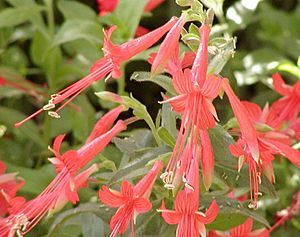California fuchsia facts for kids
Quick facts for kids California fuchsia |
|
|---|---|
 |
|
| Zauschneria flowers | |
| Scientific classification | |
| Genus: |
Epilobium
|
| Species: |
canum
|
| Synonyms | |
|
Zauschneria californica |
|
Epilobium canum, often called California fuchsia, is a beautiful plant known for its bright red flowers. It belongs to the willowherb family, which is part of the evening primrose group. This plant grows naturally in dry, sunny areas of western North America, especially in California.
It's a perennial plant, meaning it lives for more than two years. You can spot its amazing scarlet flowers blooming from late summer into autumn. People also call it hummingbird flower or hummingbird trumpet because hummingbirds love to visit its nectar-rich blooms. Another common name is firechalice, due to its fiery flower color.
The plant used to have its own genus name, Zauschneria. This name honored Johann Baptista Josef Zauschner, a professor of medicine and botany. However, scientists now group it with other Epilobium plants. Its common name, California fuchsia, comes from how much its flowers look like those of the fuchsia plant.
What is California Fuchsia?
California fuchsia is a small subshrub that can grow up to 60 centimeters (about 2 feet) tall. These plants can look quite different depending on where they grow. Their small leaves can be opposite or alternate on the stem. They might be shaped like a spear or an egg, and their color can range from green to almost white.
The plant often spreads out, forming a mat or a mound. It does this using special underground stems called rhizomes. Its tubular or funnel-shaped flowers grow in clusters at the ends of the stems. While most are reddish, you can find them in shades from bright fuchsia to pink or red-orange.
Different Types of California Fuchsia
Because these plants vary so much, scientists once described many different types, called subspecies. However, it's hard to tell them apart because they often blend into each other. Today, only a few main subspecies are still recognized:
- Epilobium canum ssp. canum
- Epilobium canum ssp. garrettii
- Epilobium canum ssp. latifolium
Growing California Fuchsia
California fuchsia is a great plant for gardens, especially in dry areas. It likes sunny spots with soil that drains water well. It's also important to protect it from strong winds. Once established, it doesn't need much watering, making it a good choice for drought-tolerant gardens.
One type, Epilobium canum ssp. canum, can survive cold temperatures down to USDA zone 8a. This means it can handle temperatures as low as -12.2 to -9.4 °C (10 to 15 °F). The Royal Horticultural Society even gave Epilobium canum an Award of Garden Merit for being an excellent garden plant.
Gardeners have also created new types of California fuchsia by cross-breeding different plants. Some of these come from isolated groups of plants, like those found on Santa Cruz Island off the California coast.

